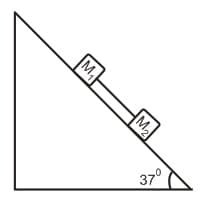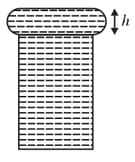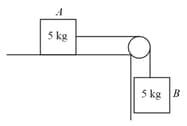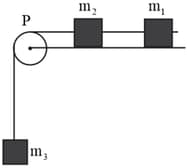Two blocks connected by a massless string slides down an inclined plane having an angle of inclination of 37°. The masses of the two blocks are M1 = 4 kg and M2 = 2 kg respectively and the coefficients of friction of M1 and M2 with the inclined plane are 0.75 and 0.25 respectively. Assuming the string to be taut, find the common acceleration of two masses

Important Questions on Mechanical Properties of Fluids
Two blocks ( and ) are arranged on a horizontal frictionless table as shown in the figure. The coefficient of static friction between the two blocks is Then the maximum horizontal force that can be applied on the larger block so that the blocks move together is (Round off to the Nearest Integer) [Take as ]

When water is filled carefully in a glass, one can fill it to a height above the rim of the glass due to the surface tension of water. To calculate just before water starts flowing, model the shape of the water above the rim as a disc of thickness having semicircular edges, as shown schematically in the figure. When the pressure of water at the bottom of this disc exceeds what can be withstood due to the surface tension, the water surface breaks near the rim and water starts flowing from there. If the density of water, its surface tension and the acceleration due to gravity are and respectively, the value of (in ) is ________.

diameter of capillary,
rise of water,
Using and the simplified relation the possible error in surface tension is closest to:
A system of two blocks of masses and is placed on a smooth table as shown in figure. The coefficient of static friction between two blocks is . The maximum horizontal force that can be applied to the block of mass so that the blocks move together will be

A block of mass resting on a horizontal surface is connected by a cord, passing over a light frictionless pulley to a hanging block of mass . The coefficient of kinetic friction between the block and the surface is . Tension in the cord is

Calculate the work done in increasing the radius of a soap bubble in air from 1 cm to 2 cm. The surface tension of the soap solution is 30 dyne/cm.

Given in the figure are two blocks and of weight and , respectively. These are being pressed against a wall by a force and kept in equilibrium as shown. If the coefficient of friction between the blocks is and between block and the wall is , the frictional force applied by the wall on block is:

